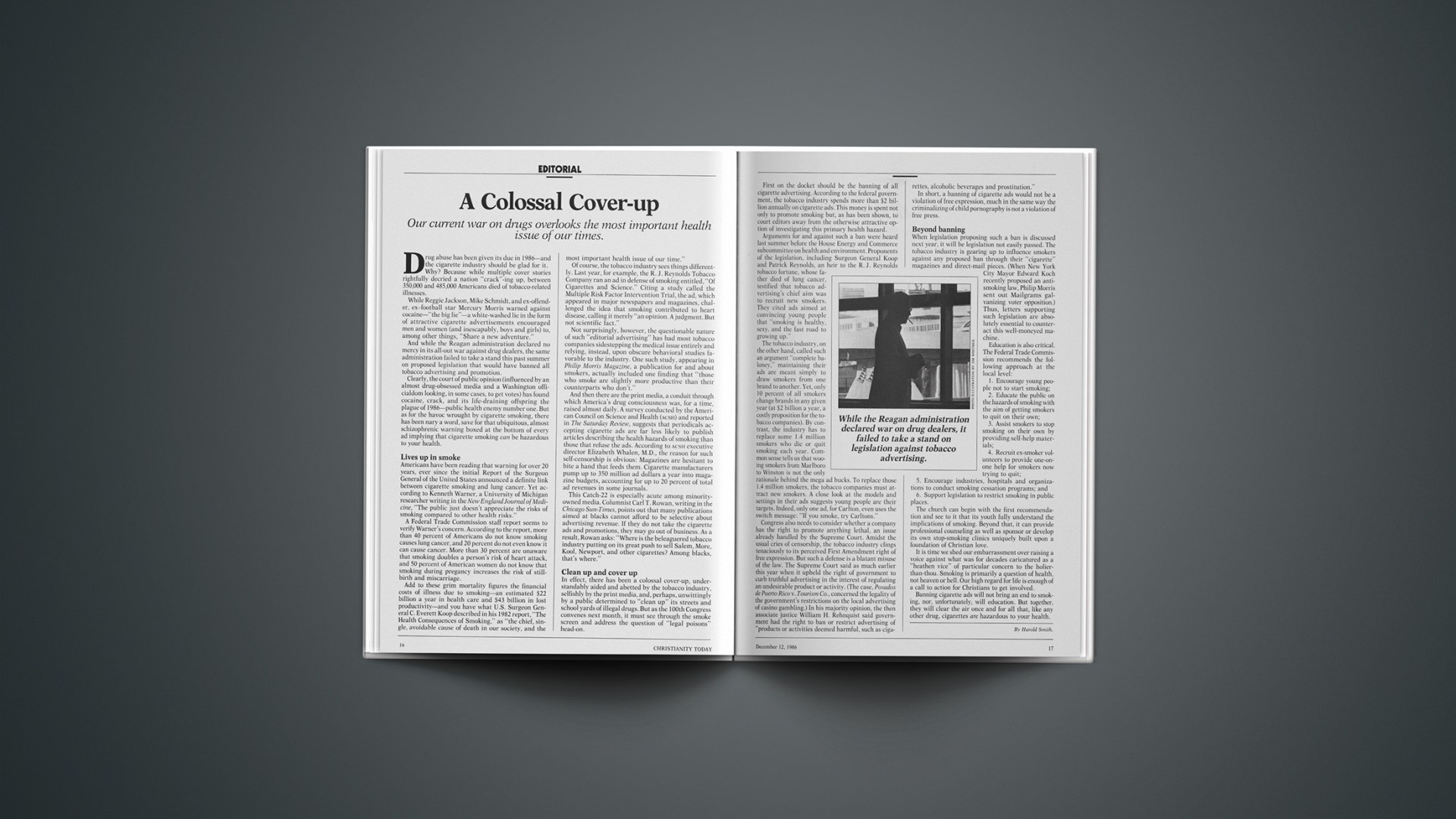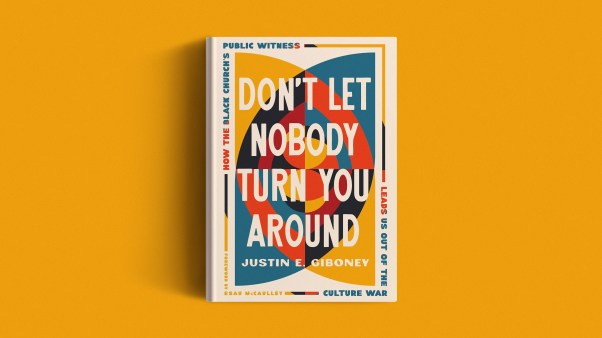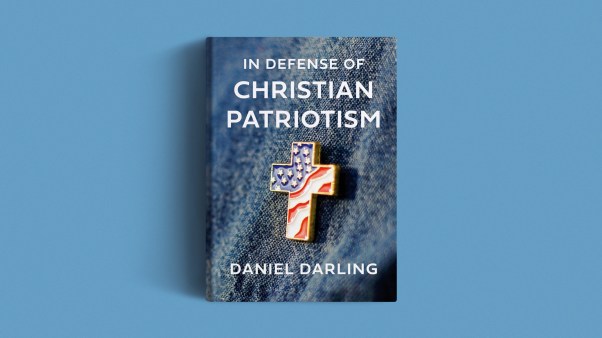Our current war on drugs overlooks the most important health issue of our times.
Drug abuse has been given its due in 1986—and the cigarette industry should be glad for it. Why? Because while multiple cover stories rightfully decried a nation “crack”-ing up, between 350,000 and 485,000 Americans died of tobacco-related illnesses.
While Reggie Jackson, Mike Schmidt, and ex-offender, ex-football star Mercury Morris warned against cocaine—“the big lie”—a white-washed lie in the form of attractive cigarette advertisements encouraged men and women (and inescapably, boys and girls) to, among other things, “Share a new adventure.”
And while the Reagan administration declared no mercy in its all-out war against drug dealers, the same administration failed to take a stand this past summer on proposed legislation that would have banned all tobacco advertising and promotion.
Clearly, the court of public opinion (influenced by an almost drug-obsessed media and a Washington officialdom looking, in some cases, to get votes) has found cocaine, crack, and its life-draining offspring the plague of 1986—public health enemy number one. But as for the havoc wrought by cigarette smoking, there has been nary a word, save for that ubiquitous, almost schizophrenic warning boxed at the bottom of every ad implying that cigarette smoking can be hazardous to your health.
Lives Up In Smoke
Americans have been reading that warning for over 20 years, ever since the initial Report of the Surgeon General of the United States announced a definite link between cigarette smoking and lung cancer. Yet according to Kenneth Warner, a University of Michigan researcher writing in the New England Journal of Medicine, “The public just doesn’t appreciate the risks of smoking compared to other health risks.”
A Federal Trade Commission staff report seems to verify Warner’s concern. According to the report, more than 40 percent of Americans do not know smoking causes lung cancer, and 20 percent do not even know it can cause cancer. More than 30 percent are unaware that smoking doubles a person’s risk of heart attack, and 50 percent of American women do not know that smoking during pregancy increases the risk of stillbirth and miscarriage.
Add to these grim mortality figures the financial costs of illness due to smoking—an estimated $22 billion a year in health care and $43 billion in lost productivity—and you have what U.S. Surgeon General C. Everett Koop described in his 1982 report, “The Health Consequences of Smoking,” as “the chief, single, avoidable cause of death in our society, and the most important health issue of our time.”
Of course, the tobacco industry sees things differently. Last year, for example, the R. J. Reynolds Tobacco Company ran an ad in defense of smoking entitled, “Of Cigarettes and Science.” Citing a study called the Multiple Risk Factor Intervention Trial, the ad, which appeared in major newspapers and magazines, challenged the idea that smoking contributed to heart disease, calling it merely “an opinion. A judgment. But not scientific fact.”
Not surprisingly, however, the questionable nature of such “editorial advertising” has had most tobacco companies sidestepping the medical issue entirely and relying, instead, upon obscure behavioral studies favorable to the industry. One such study, appearing in Philip Morris Magazine, a publication for and about smokers, actually included one finding that “those who smoke are slightly more productive than their counterparts who don’t.”
And then there are the print media, a conduit through which America’s drug consciousness was, for a time, raised almost daily. A survey conducted by the American Council on Science and Health (ACSH) and reported in The Saturday Review, suggests that periodicals accepting cigarette ads are far less likely to publish articles describing the health hazards of smoking than those that refuse the ads. According to ACSH executive director Elizabeth Whalen, M.D., the reason for such self-censorship is obvious: Magazines are hesitant to bite a hand that feeds them. Cigarette manufacturers pump up to 350 million ad dollars a year into magazine budgets, accounting for up to 20 percent of total ad revenues in some journals.
This Catch-22 is especially acute among minority-owned media. Columnist Carl T. Rowan, writing in the Chicago Sun-Times, points out that many publications aimed at blacks cannot afford to be selective about advertising revenue. If they do not take the cigarette ads and promotions, they may go out of business. As a result, Rowan asks: “Where is the beleaguered tobacco industry putting on its great push to sell Salem, More, Kool, Newport, and other cigarettes? Among blacks, that’s where.”
Clean Up And Cover Up
In effect, there has been a colossal cover-up, understandably aided and abetted by the tobacco industry, selfishly by the print media, and, perhaps, unwittingly by a public determined to “clean up” its streets and school yards of illegal drugs. But as the 100th Congress convenes next month, it must see through the smoke screen and address the question of “legal poisons” head-on.
First on the docket should be the banning of all cigarette advertising. According to the federal government, the tobacco industry spends more than $2 billion annually on cigarette ads. This money is spent not only to promote smoking but, as has been shown, to court editors away from the otherwise attractive option of investigating this primary health hazard.
Arguments for and against such a ban were heard last summer before the House Energy and Commerce subcommittee on health and environment. Proponents of the legislation, including Surgeon General Koop and Patrick Reynolds, an heir to the R. J. Reynolds tobacco fortune, whose father died of lung cancer, testified that tobacco advertising’s chief aim was to recruit new smokers. They cited ads aimed at convincing young people that “smoking is healthy, sexy, and the fast road to growing up.”
The tobacco industry, on the other hand, called such an argument “complete baloney,” maintaining their ads are meant simply to draw smokers from one brand to another. Yet, only 10 percent of all smokers change brands in any given year (at $2 billion a year, a costly proposition for the tobacco companies). By contrast, the industry has to replace some 1.4 million smokers who die or quit smoking each year. Common sense tells us that wooing smokers from Marlboro to Winston is not the only rationale behind the mega ad bucks. To replace those 1.4 million smokers, the tobacco companies must attract new smokers. A close look at the models and settings in their ads suggests young people are their targets. Indeed, only one ad, for Carlton, even uses the switch message: “If you smoke, try Carltons.”
Congress also needs to consider whether a company has the right to promote anything lethal, an issue already handled by the Supreme Court. Amidst the usual cries of censorship, the tobacco industry clings tenaciously to its perceived First Amendment right of free expression. But such a defense is a blatant misuse of the law. The Supreme Court said as much earlier this year when it upheld the right of government to curb truthful advertising in the interest of regulating an undesirable product or activity. (The case, Posados de Puerto Rico v. Tourism Co., concerned the legality of the government’s restrictions on the local advertising of casino gambling.) In his majority opinion, the then associate justice William H. Rehnquist said government had the right to ban or restrict advertising of “products or activities deemed harmful, such as cigarettes, alcoholic beverages and prostitution.”
In short, a banning of cigarette ads would not be a violation of free expression, much in the same way the criminalizing of child pornography is not a violation of free press.
Beyond Banning
When legislation proposing such a ban is discussed next year, it will be legislation not easily passed. The tobacco industry is gearing up to influence smokers against any proposed ban through their “cigarette” magazines and direct-mail pieces. (When New York City Mayor Edward Koch recently proposed an antismoking law, Philip Morris sent out Mailgrams galvanizing voter opposition.) Thus, letters supporting such legislation are absolutely essential to counteract this well-moneyed machine.
Education is also critical. The Federal Trade Commission recommends the following approach at the local level:
- Encourage young people not to start smoking;
- Educate the public on the hazards of smoking with the aim of getting smokers to quit on their own;
- Assist smokers to stop smoking on their own by providing self-help materials;
- Recruit ex-smoker volunteers to provide one-on-one help for smokers now trying to quit;
- Encourage industries, hospitals and organizations to conduct smoking cessation programs; and
- Support legislation to restrict smoking in public places.
The church can begin with the first recommendation and see to it that its youth fully understand the implications of smoking. Beyond that, it can provide professional counseling as well as sponsor or develop its own stop-smoking clinics uniquely built upon a foundation of Christian love.
It is time we shed our embarrassment over raising a voice against what was for decades caricatured as a “heathen vice” of particular concern to the holier-than-thou. Smoking is primarily a question of health, not heaven or hell. Our high regard for life is enough of a call to action for Christians to get involved.
Banning cigarette ads will not bring an end to smoking, nor, unfortunately, will education. But together, they will clear the air once and for all that, like any other drug, cigarettes are hazardous to your health.
By Harold Smith.










